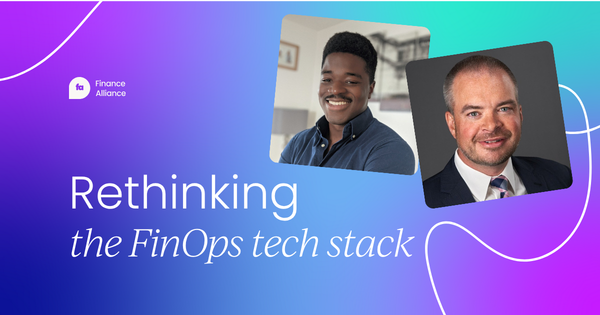AI is no longer a side project sitting at the fringes of finance. For many teams, it’s becoming the difference between barely closing the books on time and actually helping shape where the business goes next.
Their message is clear: AI won’t replace the finance function but it will fundamentally reshape what it spends its time on.
“The fun part of these jobs is to be able to sit there and really dig into what the data means. Not to spend all your time just trying to get to the point where you can start the analysis.” – Mathew Reynders, Executive Vice President, FP&A and Investor Relations at Teads
This is where AI in the FinOps tech stack comes in: less time wrestling spreadsheets and reconciliations, more time asking better questions, testing more scenarios, and delivering insight when it’s actually useful.
More than an ERP upgrade
Ask ten people what sits in the “FinOps tech stack” and you’ll probably get ten different answers. Marvin’s starting point is to strip away the hype and define it in practical terms.
In his words, the FinOps tech stack is the combined system of record and system of work for the finance function: the accounting or ERP system, planning tools, billing and revenue systems, operational integrations to sales or delivery platforms, and all the adjacent tooling used to run finance day to day.
Crucially, it’s not just about one big monolithic application. It’s an ecosystem of tools passing structured data between each other: journals, invoices, timesheets, contracts, forecasts, actuals.
That structure is exactly what makes finance such fertile ground for AI.
“When you’re operating with high volumes of structured data and repetitive processes, you get a really powerful use case for AI. You’re taking large data sets and asking the same questions over and over again. That’s where technology can do a lot of the heavy lifting.” – Marvin Fletcher Rogers, Principal Consultant & Head of Business Development at Sage
In other words, the revolution doesn’t come from ripping out your stack and starting again. It comes from embedding intelligence into the tools you already rely on, so the system can do more of the work before it ever hits a human’s desk.
From hunting for data to asking better questions
For most finance teams, the biggest bottleneck isn’t brainpower. It’s time.
Mathew described a familiar reality: teams working late to validate figures, extract data, reconcile differences and chase down missing pieces before they can even begin to interpret performance.
“We spend a lot of time trying to make sure we’re accurate and that we’ve got the right information. You lose valuable time in those cycles of just getting to the point where you can start to think about what it means.”
When that pattern repeats month after month, it quietly downgrades the role of finance. Analysts and controllers who were hired for their judgment and strategic thinking end up spending their energy copying, checking and cleaning.
AI does not magically solve every data issue. But it can fundamentally rebalance where the effort goes.
If the system can ingest transactions, apply learned patterns, flag anomalies and pre-prepare reconciliations, humans are no longer stuck in first gear. They can arrive at the analysis stage earlier in the process and stay there longer.
“It’s hard to be strategic if you’re constantly worrying whether the data is correctly assembled. The whole point is to free up time so teams can focus on the ‘why’, not just the ‘what’.”
That shift might sound subtle, but it changes how finance shows up to every conversation. Instead of walking in saying, “We’re still waiting on the final numbers,” they can sit down and say, “Here’s what’s happening, here’s why, and here are the options.”
Automating the “boring but critical” parts of finance
The most powerful AI use cases in finance aren’t necessarily the flashiest. They’re the ones that quietly take the worst manual work off people’s plates.
Marvin pointed straight at month-end and quarter-end as prime examples. In many organizations, closing the books isn’t delayed because no one knows what happened. It’s delayed because thousands of tiny, repetitive tasks have to be performed and checked.
Think of reconciliations between bank statements and ledgers, deferrals and accruals, cost allocations, depreciation runs, revenue recognition schedules and adjustments for fat-fingered entries.
“So much of the close is taken up by reconciliations, adjustments and allocations. All of those are essential, but they are also highly repetitive and often predictable.”
This is precisely where AI and automation can earn their keep. Tools can learn what a typical journal looks like, which dimensions are usually used together, how a particular customer or vendor is normally coded, and which patterns signal a likely error.
Instead of someone spotting a mistake only when they review a report days later, the system can surface it immediately:
“Every month you post this entry to payroll; this time the amount is ten times higher. Are you sure?”
That same pattern extends to:



 Follow us on LinkedIn
Follow us on LinkedIn



